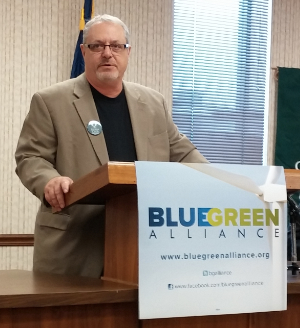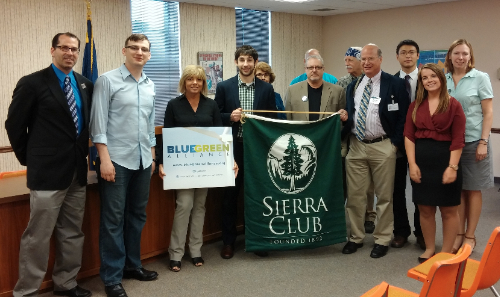KALAMAZOO, MI -- How do Michigan farmers and consumers feel about food from local farmers?
Since last month Erin Denay has been posing that question at farmers markets across the state to create enough video snippets to roll out one a day during the month of July, part of a collaborative project with Sierra Club, said Gail Philbin, assistant director of the Sierra Club Michigan Chapter.
"We really want consumers and farmers already involved in the sustainable agriculture scene to understand there are people supporting them," said Denay, 22, of Bay City. She is a senior at Western Michigan University majoring in environmental and sustainability studies and organizational communication.
Sustainable agriculture, she said, is farming that "revolves around the well-being of the surrounding environment, people, and animals while producing healthy, high-quality food that protects the quality of the land and water for future generations.
In the series of one-minute video testimonials produced by the Less=More sustainable agriculture coalition, Michigan residents talk about why meat, dairy, poultry and eggs that are locally grown under humane conditions are important to them, their communities and local economies, a news release from Sierra Club said.
"Sustainable agriculture is farming that revolves around the well-being of the surrounding environment, people, and animals," Denay said, " so as to produce healthy, high-quality food that protects the quality of the land and water for future generations."
"We want them to know we are here for them," Denay said, "and to draw more attention and tax dollars to them," the farms practicing sustainable agriculture methods.
Maynard Beery of Beery Farms in Middleville, for instance, told Denay that though he could not keep up with soaring demand for his grass fed beef "there is no way that I can compete with a 50,000 animal feedlot. They're happy if they wind up with $10 a head in profit and no, that's not going to support myself and my son."
Farm subsidies for which he currently does not qualify would allow his farm to expand, he said.
The project also hopes to let people know there are 300 farmers markets in Michigan, and lots of choices when it comes to shopping for food. "We want to illuminate the opportunities to eat local, sustainable healthy food," Denay said.
What were the most promising findings of Denay's interviews?
"The appetite, pardon the pun, for local, healthy food is alive and well in Michigan," Philbin said.
The series kicks off July 1 with the release of the testimonial of Jill Johnson and Mary Wills of Crane Dance Farm in Middleville via Less=More's Twitter account, @MoreforMichigan, and its Facebook page.
The remainder of that week the videos feature Kalamazoo farmers and consumers, Denay said.
"Being involved with this project has made me so much more aware of the healthy, high-quality food that is being made available by small-scale sustainable farmers in Michigan communities," Denay said. "I want this testimonial series to really highlight the wonderful things they are doing and why they deserve our support so they can succeed and grow and continue to provide for their communities."
Sierra Club believes issues such as antibiotic overuse, the viability of local economies, climate change, fair wages and working conditions for workers and animal welfare can be traced back to how food is grown.
"Many consumers are searching for a way to have some control over the food they eat because they are disillusioned or disgusted with the industrial food system," she said. "Growing your own food or buying from local farmers they know is a good way to do that."
Sierra Club is a member of the Less=More Coalition, producers of the video series. The group is made up of national, state and local organizations as well as consumers and farmers who support sustainable agriculture and seek to level the playing field for sustainable livestock farmers.
Specifically, the coalition is tackling inequities in the subsidy system that the coalition argues is weighted toward concentrated livestock operations.
In 2013, the coalition's report "Restoring the Balance to Michigan's Farming Landscape" noted that some farms continue to receive taxpayer-funded subsidies even when they have been fined for violations of environmental law and blasted the farm subsidy system for favoring concentrated animal feeding operations in the award of funds.
Less=More members include: Beery Farms of Michigan, LLC, the Center for Food Safety, Crane Dance Farm, LLC, ELFCO Food Cooperative, Environmentally Concerned Citizens of South Central Michigan, Food & Water Watch, Greater Grand Rapids Food Systems Council, Groundswell Farm, Zeeland, Humane Society of the United States, Michigan Farmers Union, Michigan Small Farm Council, Michigan Student Sustainability Coalition, Michigan Voices for Good Food Policy, Michigan Young Farmers Coalition, Sierra Club Michigan Chapter and Socially Responsible Agricultural Project.
The coalition is also asking people to contribute their own food stories to the series. For more information on submitting a testimonial, email:Moreformichigansc@gmail.com
"We want them to know we are here for them," Denay said, "and to draw more attention and tax dollars to them," the farms practicing sustainable agriculture methods.
Maynard Beery of Beery Farms in Middleville, for instance, told Denay that though he could not keep up with soaring demand for his grass fed beef "there is no way that I can compete with a 50,000 animal feedlot. They're happy if they wind up with $10 a head in profit and no, that's not going to support myself and my son."
Farm subsidies for which he currently does not qualify would allow his farm to expand, he said.
The project also hopes to let people know there are 300 farmers markets in Michigan, and lots of choices when it comes to shopping for food. "We want to illuminate the opportunities to eat local, sustainable healthy food," Denay said.
What were the most promising findings of Denay's interviews?
"The appetite, pardon the pun, for local, healthy food is alive and well in Michigan," Philbin said.
The series kicks off July 1 with the release of the testimonial of Jill Johnson and Mary Wills of Crane Dance Farm in Middleville via Less=More's Twitter account, @MoreforMichigan, and its Facebook page.
The remainder of that week the videos feature Kalamazoo farmers and consumers, Denay said.
"Being involved with this project has made me so much more aware of the healthy, high-quality food that is being made available by small-scale sustainable farmers in Michigan communities," Denay said. "I want this testimonial series to really highlight the wonderful things they are doing and why they deserve our support so they can succeed and grow and continue to provide for their communities."
Sierra Club believes issues such as antibiotic overuse, the viability of local economies, climate change, fair wages and working conditions for workers and animal welfare can be traced back to how food is grown.
"Many consumers are searching for a way to have some control over the food they eat because they are disillusioned or disgusted with the industrial food system," she said. "Growing your own food or buying from local farmers they know is a good way to do that."
Sierra Club is a member of the Less=More Coalition, producers of the video series. The group is made up of national, state and local organizations as well as consumers and farmers who support sustainable agriculture and seek to level the playing field for sustainable livestock farmers.
Specifically, the coalition is tackling inequities in the subsidy system that the coalition argues is weighted toward concentrated livestock operations.
In 2013, the coalition's report "Restoring the Balance to Michigan's Farming Landscape" noted that some farms continue to receive taxpayer-funded subsidies even when they have been fined for violations of environmental law and blasted the farm subsidy system for favoring concentrated animal feeding operations in the award of funds.
Less=More members include: Beery Farms of Michigan, LLC, the Center for Food Safety, Crane Dance Farm, LLC, ELFCO Food Cooperative, Environmentally Concerned Citizens of South Central Michigan, Food & Water Watch, Greater Grand Rapids Food Systems Council, Groundswell Farm, Zeeland, Humane Society of the United States, Michigan Farmers Union, Michigan Small Farm Council, Michigan Student Sustainability Coalition, Michigan Voices for Good Food Policy, Michigan Young Farmers Coalition, Sierra Club Michigan Chapter and Socially Responsible Agricultural Project.
The coalition is also asking people to contribute their own food stories to the series. For more information on submitting a testimonial, email:Moreformichigansc@gmail.com








